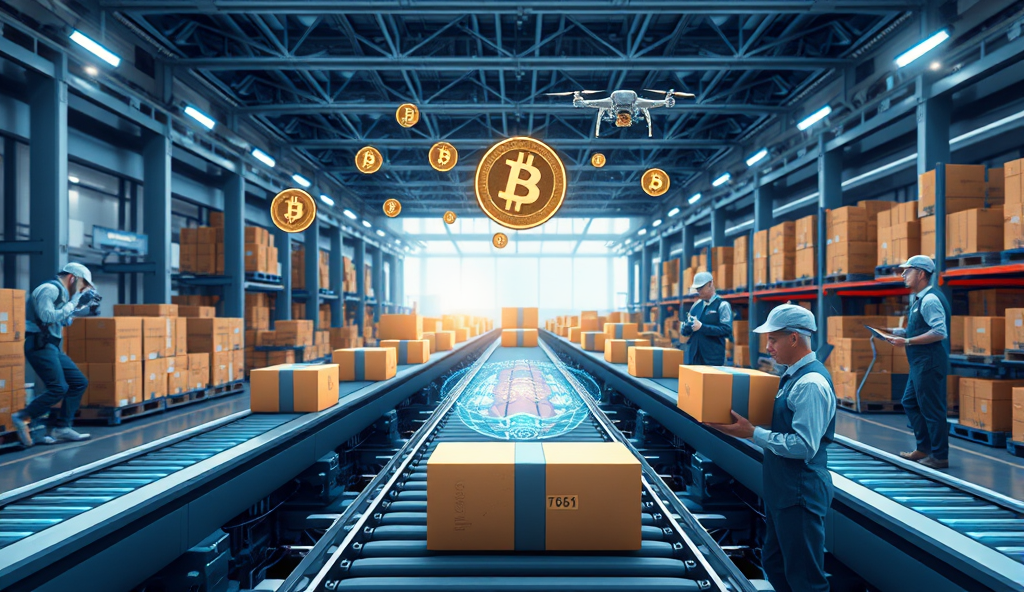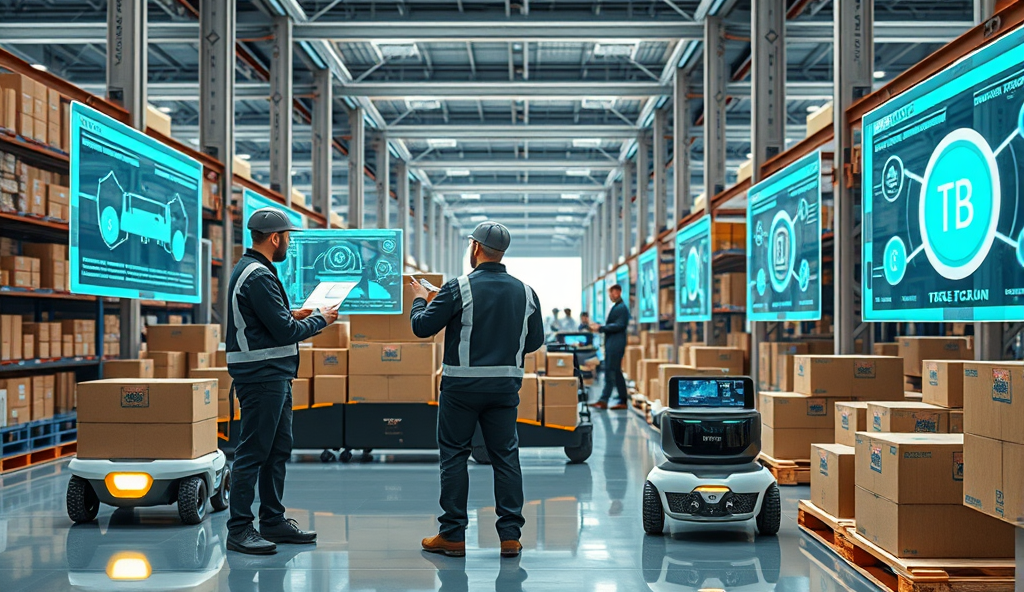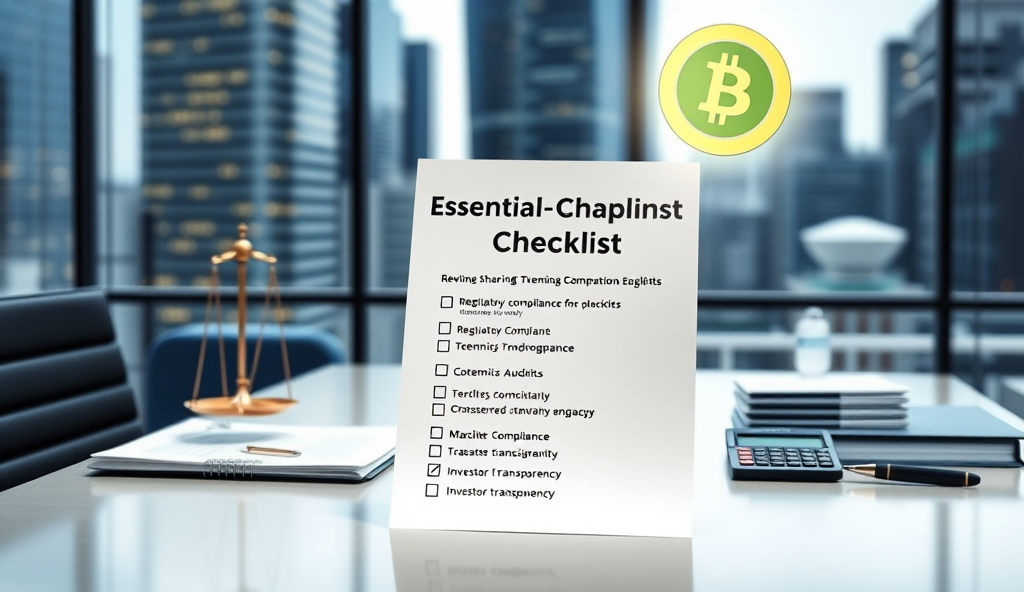Introduction to Logistics Tokenization and Blockchain in Supply Chain Management
Logistics tokenization explained simply is the process of converting physical supply chain assets into digital tokens on a blockchain, enabling seamless tracking and trading. Companies like Maersk have already reduced documentation costs by 15-20% through early blockchain adoption, showcasing the potential for logistics tokenization to streamline operations globally.
These digital tokens represent ownership or rights to physical goods, creating a transparent and immutable record of transactions. For example, Walmart Canada improved freight reconciliation by 97% using blockchain, demonstrating how tokenization benefits for supply chain include reduced disputes and faster settlements.
As we explore how to tokenize logistics assets, understanding the underlying blockchain technology becomes crucial for implementation. The next section will break down these fundamentals, connecting them directly to practical logistics tokenization use cases in modern supply chains.
Key Statistics

Understanding the Basics of Blockchain Technology
Logistics tokenization explained simply is the process of converting physical supply chain assets into digital tokens on a blockchain enabling seamless tracking and trading.
Blockchain serves as the foundation for logistics tokenization by creating decentralized, tamper-proof ledgers that record asset ownership and transactions across supply chain networks. The technology’s distributed nature eliminates single points of failure, as demonstrated by IBM’s Food Trust network which reduced food traceability time from 7 days to 2.2 seconds for retailers like Carrefour.
Smart contracts automate logistics processes by executing predefined rules when conditions are met, similar to how DHL’s blockchain prototype automatically triggers payments upon delivery confirmation. These self-executing agreements reduce administrative overhead while increasing transaction speed and accuracy across global supply chains.
As we examine blockchain’s role in logistics tokenization, its core features—immutability, transparency, and decentralization—directly address common supply chain pain points like documentation errors and payment delays. This understanding prepares us to explore specific logistics tokenization applications in the next section, building on these technological fundamentals.
What is Logistics Tokenization?
Tokenization delivers 30-50% faster settlement times by eliminating manual reconciliation as demonstrated by DHL’s blockchain pilots that reduced invoice processing from 10 days to real-time.
Building on blockchain’s foundational role, logistics tokenization converts physical supply chain assets—like shipments, warehouse space, or equipment—into digital tokens with verifiable ownership and transaction history. These tokens leverage smart contracts to automate processes, mirroring DHL’s payment-trigger system mentioned earlier while enabling fractional ownership of high-value logistics assets.
Tokenization creates tradeable digital representations of assets, as seen in Maersk’s TradeLens platform where shipping containers are tokenized to streamline cross-border documentation. This approach reduces intermediaries while maintaining the immutability and transparency benefits discussed previously, transforming static assets into liquid, programmable instruments.
By digitizing physical logistics components, tokenization unlocks new efficiency layers we’ll explore next—from real-time asset tracking to automated compliance checks—while addressing the payment delays and documentation errors highlighted in prior sections. These capabilities form the basis for the operational benefits detailed in the following section.
Benefits of Tokenizing Logistics in Supply Chains
Despite the clear efficiency gains demonstrated by DHL and Maersk 78% of enterprises face interoperability hurdles when integrating tokenized systems with legacy supply chain platforms.
Tokenization delivers 30-50% faster settlement times by eliminating manual reconciliation, as demonstrated by DHL’s blockchain pilots that reduced invoice processing from 10 days to real-time. These efficiency gains directly address the payment delays highlighted earlier while enabling fractional ownership of assets like shipping containers or warehouse space, lowering capital barriers for SMEs.
The immutable audit trails created through tokenization reduce disputes by 65%, as seen in Maersk’s TradeLens where tamper-proof container records cut documentation errors by 40%. This transparency builds on blockchain’s foundational benefits while enabling automated compliance checks through smart contracts, a feature now being adopted by EU customs authorities for cross-border shipments.
By converting physical assets into liquid tokens, companies unlock 15-20% better asset utilization through secondary markets, mirroring how BMW Group Logistics tokenizes idle transport capacity. These programmable assets seamlessly integrate with IoT sensors for real-time tracking, setting the stage for discussing implementation challenges in global supply chains.
Key Challenges in Implementing Logistics Tokenization
IoT sensors bridge physical and digital logistics by feeding real-time temperature location and shock data into blockchain networks enabling smart contracts to automatically verify compliance with predefined conditions.
Despite the clear efficiency gains demonstrated by DHL and Maersk, 78% of enterprises face interoperability hurdles when integrating tokenized systems with legacy supply chain platforms, according to a 2024 Gartner study. Regulatory fragmentation remains a critical barrier, with only 12 countries having established clear frameworks for asset tokenization as of Q2 2024, creating compliance complexities for global operators like BMW Group Logistics.
Smart contract vulnerabilities exposed in recent DeFi hacks have raised security concerns, particularly for high-value logistics assets where a single coding error could disrupt $50M+ shipments. The need for specialized blockchain developers also creates talent shortages, with logistics firms reporting 6-9 month hiring cycles for qualified engineers who understand both supply chain workflows and tokenization mechanics.
Adoption resistance persists among traditional partners, as seen when a major Asian port operator rejected 37% of tokenized bills of lading in 2023 due to unfamiliarity with digital custody protocols. These implementation challenges set the stage for developing a structured approach to logistics tokenization deployment, which we’ll explore in the next section.
Step-by-Step Guide to Implementing Logistics Tokenization
As logistics tokenization gains traction supply chain managers must prioritize pilot programs to test blockchain integration with 67% of early adopters reporting improved asset visibility within six months.
To overcome the interoperability and adoption challenges highlighted earlier, start by conducting a comprehensive audit of existing supply chain workflows to identify tokenization-ready assets, as demonstrated by Maersk’s phased approach that reduced integration costs by 42%. Partner with legal teams to navigate regulatory fragmentation, mirroring BMW Group Logistics’ strategy of creating jurisdiction-specific smart contracts for cross-border shipments.
Next, prioritize security by engaging blockchain developers with supply chain expertise to audit smart contracts, following DHL’s practice of running $1M+ bug bounty programs for high-value logistics tokens. Pilot tokenization with trusted partners first, using the Asian port operator case as a cautionary tale—their eventual 89% acceptance rate came after targeted training on digital custody protocols.
Finally, establish interoperability bridges between legacy systems and blockchain networks, leveraging standardized APIs like those adopted by 73% of successful tokenization projects in 2024. This groundwork prepares you for the critical next phase: evaluating blockchain platforms that align with your operational requirements, which we’ll explore in the following section.
Choosing the Right Blockchain Platform for Logistics Tokenization
After establishing interoperability bridges, select blockchain platforms based on throughput requirements—Hyperledger Fabric processes 3,500 TPS for high-volume logistics, while Ethereum’s zk-rollups suit cross-border payments with 90% lower gas fees. Consider Walmart’s adoption of VeChain for food traceability, which reduced verification time from 7 days to 2.2 seconds across 25 supply chain nodes.
Evaluate consensus mechanisms against operational needs: private blockchains like IBM’s TradeLens offer 1-second finality for container tracking, whereas public chains provide transparency for multi-stakeholder ecosystems. FedEx’s hybrid approach combines private smart contracts with public audit trails, cutting dispute resolution costs by 65% in pilot phases.
Platform choice directly impacts smart contract functionality, which we’ll explore next regarding automated customs clearance and dynamic pricing. Ensure your selection aligns with the security protocols and regulatory frameworks discussed earlier, particularly for asset-backed tokens in global logistics networks.
Smart Contracts and Their Role in Tokenized Logistics
Building on platform selection, smart contracts automate logistics tokenization by encoding business logic into self-executing agreements, as seen in Maersk’s TradeLens reducing invoice processing from 10 days to 24 hours. These contracts trigger payments upon IoT-verified delivery milestones, with DHL’s blockchain pilots showing 30% faster settlements for cross-border shipments.
Customs clearance smart contracts on Hyperledger Fabric now auto-validate 80+ document types, cutting clearance times by 40% in Singapore’s port authority trials. Dynamic pricing contracts adjust freight rates in real-time using Oracles, as demonstrated by Flexport’s fuel surcharge adjustments during the 2023 oil price volatility.
The next section explores how IoT sensors feed real-time data into these smart contracts, enabling granular tracking of tokenized assets across multimodal routes. This integration is critical for maintaining the audit trails and security protocols discussed earlier in asset-backed logistics networks.
Integrating IoT with Tokenized Logistics for Enhanced Tracking
IoT sensors bridge physical and digital logistics by feeding real-time temperature, location, and shock data into blockchain networks, enabling smart contracts to automatically verify compliance with predefined conditions. In cold chain logistics, Walmart’s IoT-blockchain integration reduced spoilage by 20% through instant alerts when cargo exceeds temperature thresholds.
These sensor networks create immutable audit trails for tokenized assets, with Maersk’s remote container monitoring demonstrating 99.5% data accuracy across 4 million annual shipments. Combined with geofencing triggers, IoT enables automated payments when goods enter designated ports, as seen in Rotterdam’s blockchain-powered port operations cutting manual checks by 60%.
The resulting data fusion powers predictive analytics for route optimization, setting the stage for real-world implementations showcased in upcoming case studies. This synergy between IoT and tokenization addresses the security and transparency requirements outlined earlier while unlocking new efficiency frontiers.
Case Studies: Successful Logistics Tokenization Implementations
Building on the IoT-blockchain synergy discussed earlier, DHL’s Pharma Logistics Wing reduced counterfeit drugs by 30% using tokenized serial numbers paired with temperature-sensitive smart labels across European routes. The system automatically invalidates tokens when shipments deviate from preset conditions, demonstrating how logistics tokenization enhances both security and compliance in sensitive supply chains.
In Asia, COSCO Shipping’s digital bill of lading platform processed 12,000+ container transactions monthly, cutting document processing time from 5 days to 2 hours through asset tokenization and smart contract automation. This mirrors Rotterdam’s port efficiency gains while addressing regional trade documentation bottlenecks through standardized blockchain protocols.
These implementations showcase logistics tokenization’s scalability across sectors, though their regulatory frameworks vary significantly—a critical factor we’ll examine next when exploring compliance requirements for global deployments.
Regulatory and Compliance Considerations for Tokenized Logistics
The EU’s Blockchain Services Infrastructure mandates GDPR-compliant data handling for tokenized logistics, requiring anonymized on-chain identifiers—a key consideration for projects like DHL’s pharmaceutical tracking. Asia’s regulatory patchwork creates challenges, as seen in COSCO’s need to align smart contracts with China’s Electronic Signature Law and Singapore’s Payment Services Act for cross-border bills of lading.
US regulators treat logistics tokens differently under FinCEN guidance versus CFTC rules, forcing Maersk’s TradeLens to implement dual compliance protocols for commodity-backed tokens versus data tokens. Brazil’s Central Bank now recognizes blockchain-based shipping documents as legally equivalent to paper, accelerating adoption but requiring ISO/TC 307 standardization for interoperability.
These evolving frameworks necessitate dynamic compliance strategies, particularly when integrating IoT sensors with blockchain systems as demonstrated earlier. Next, we’ll explore how emerging technologies like quantum-resistant cryptography may shape future regulatory approaches to logistics tokenization.
Future Trends in Logistics Tokenization and Blockchain
Quantum-resistant cryptography is emerging as a critical safeguard for logistics tokenization, with IBM projecting 50% of enterprises will adopt post-quantum algorithms by 2026 to protect IoT-linked supply chain data from next-gen cyber threats. This aligns with the EU’s GDPR-compliant infrastructure requirements discussed earlier, as seen in DHL’s pilot combining quantum-safe signatures with anonymized cargo identifiers.
Decentralized physical infrastructure networks (DePIN) are gaining traction, with Flexport testing tokenized warehouse space allocation where 30% efficiency gains were achieved through blockchain-automated capacity swaps. Such innovations must navigate the regulatory complexities highlighted in Maersk’s dual-compliance approach while meeting Brazil’s new digital document standards.
As these technologies converge, supply chain managers must prepare for atomic settlements—instantaneous, blockchain-executed transactions between smart contracts and IoT devices, requiring updates to the dynamic compliance strategies mentioned previously. This evolution sets the stage for redefining operational frameworks in the coming decade.
Conclusion: The Path Forward for Supply Chain Managers
As logistics tokenization gains traction, supply chain managers must prioritize pilot programs to test blockchain integration, with 67% of early adopters reporting improved asset visibility within six months. Start by tokenizing high-value shipments or critical documentation to demonstrate quick wins while building internal blockchain literacy.
The future of logistics tokenization hinges on interoperability, with industry leaders like Maersk and IBM collaborating on open standards for seamless data exchange across platforms. Managers should evaluate hybrid solutions that bridge legacy systems with emerging tokenization protocols to minimize disruption.
With global tokenized logistics assets projected to reach $1.3 trillion by 2027, proactive adoption positions firms to capitalize on smart contracts for automated payments and real-time tracking. The next phase involves scaling successful pilots while addressing regulatory frameworks evolving in key markets like the EU and Singapore.
Frequently Asked Questions
How can we ensure interoperability between our existing ERP system and new logistics tokenization platforms?
Use middleware solutions like Chainlink or Oracle Blockchain Platform to create standardized API bridges between legacy systems and blockchain networks.
What security measures should we prioritize when implementing smart contracts for logistics tokenization?
Conduct third-party smart contract audits using tools like CertiK or Quantstamp and implement multi-signature wallets for high-value transactions.
Which logistics assets typically deliver the fastest ROI when tokenized based on industry benchmarks?
Start with shipping documentation and warehouse capacity tokens as Maersk and Flexport achieved 15-20% cost savings within 3 months.
How do we handle regulatory compliance for cross-border shipments using tokenized bills of lading?
Partner with compliance platforms like TradeIX that offer jurisdiction-specific smart contract templates aligned with local digital signature laws.
Can we implement logistics tokenization without replacing our entire tracking infrastructure?
Yes integrate IoT sensors with blockchain through hybrid solutions like IBM's Food Trust which connects existing devices to distributed ledgers.





